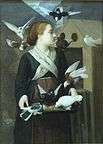Sava Henția
| Sava Henția | |
|---|---|
.jpg) Photo ~ 1880 - 1894 | |
| Born |
Sava 1 February 1848 Sebeșel |
| Died | 21 September 1904 |
| Nationality | Romanian |
| Education | Bucharest National University of Arts, Académie des Beaux-Arts |
| Known for | painter, illustrator, muralist |
| Movement | realism |

(Ana Dăncilă)
Sava Henția (1 February 1848, Sebeșel - 21 February 1904, Sebeșel) was an Imperial Austrian-born Romanian painter, decorator and illustrator.
Biography
He was one of fourteen surviving children of a priest. In 1862, after finishing his primary education, he was apprenticed to an uncle, who taught him how to retouch photographs.[1] The following year, he caught typhoid fever and the quinine that was used to treat it damaged his hearing.[2]
His work with photographs encouraged him to pursue a career in art. From 1865 to 1870, he studied at the Bucharest National University of Arts with Gheorghe Tattarescu and Theodor Aman.[1] He was then able to obtain a scholarship and went to Paris, where he enrolled at the Académie des Beaux-Arts and found a position in the prestigious workshop of Alexandre Cabanel. In 1873, he returned to Bucharest and became a teacher of drawing and calligraphy at the "Elena Doamna" orphan asylum.[1]
Four years later, on the recommendation of Doctor Carol Davila, he became a correspondent with the Army ambulance corps and participated in the Russo-Turkish War (War of Independence), sketching numerous scenes of campaigns and battles, many of which he later made into watercolors.[2] His painting of an artillery battery from Calafat was used on a one Leu postage stamp in 1977.[3]
After the war, he worked as a teacher, interior decorator and book illustrator.[1] Between 1901 and 1902, he was one of the artists commissioned to restore the murals and altarpieces at the Brebu Monastery. At the Cernica Monastery, he produced portraits of that institution's founders.
His home in Sebeș became an historical monument. It was not properly maintained, however, and the roof collapsed in 2001. After further deterioration, all that remained was the front wall and foundation. It was later taken off the list of historical monuments. A street in Bucharest is named after him.
Selected paintings
 Brothers (1882)
Brothers (1882) Girl with Pigeons (1875)
Girl with Pigeons (1875) Adoptive Mother (1890)
Adoptive Mother (1890) Portrait of a Gypsy (1881)
Portrait of a Gypsy (1881)
References
- 1 2 3 4 Brief biography @ the Sebeș website.
- 1 2 Iulia Ramona Dan. "Noi contribuții la cunoașterea vieții șl activității pictorului Sava Henția (1848-1904) (New contributions to our knowledge of the life and work of Sava Henția), with photographs".
- ↑ "Romania 1 Leu stamp". stampdata.com.
Further reading
- Mircea Popescu, Sava Henția, Editura de Stat pentru Literatură și Artă, 1954
- Livia Drăgoi, Sava Henția, (exhibition catalog), Cluj Museum of Art, Editura Meridiane, 1974
External links
| Wikimedia Commons has media related to Sava Henția. |
- Arcadja Auctions: More works by Henția
- Masterpieces of Sava Henția a video from EU Screen